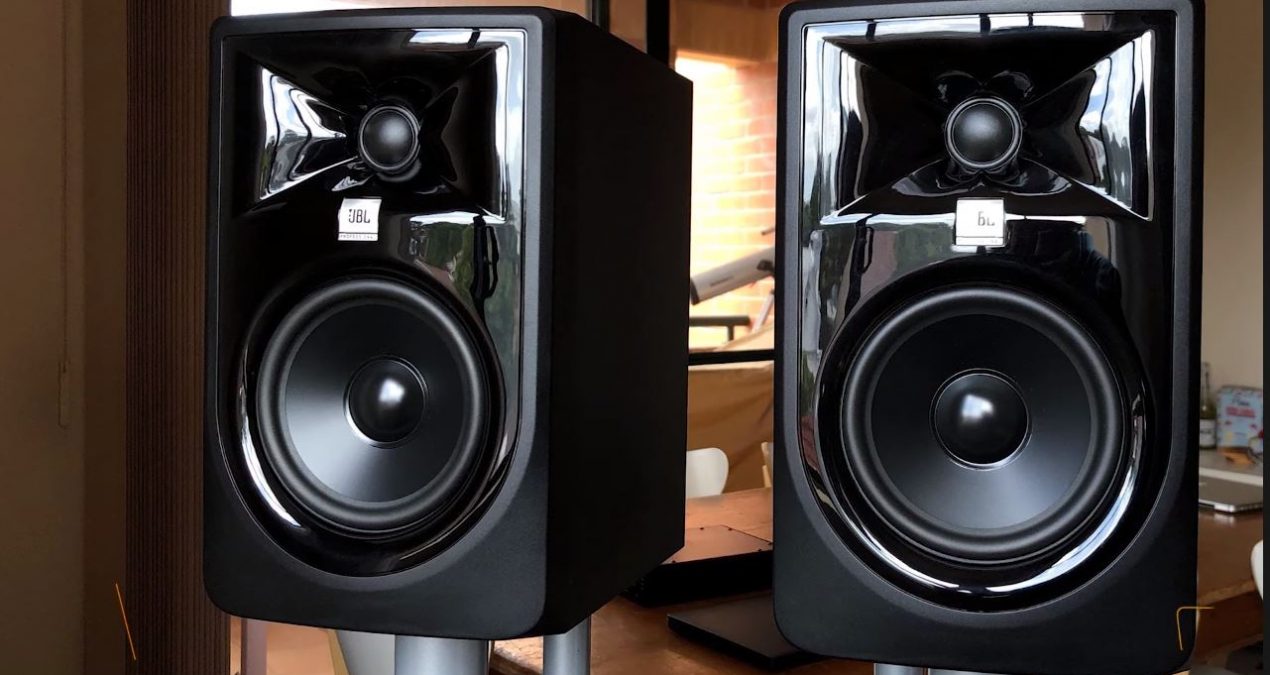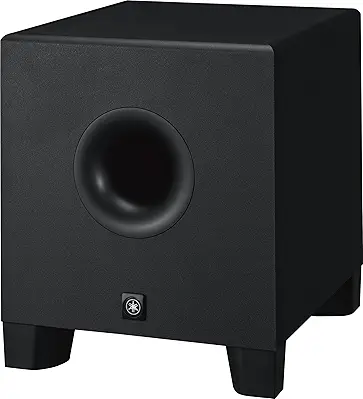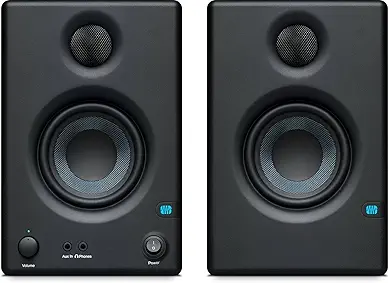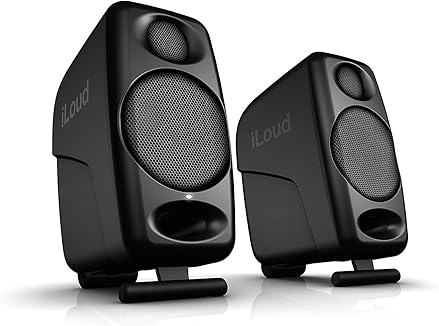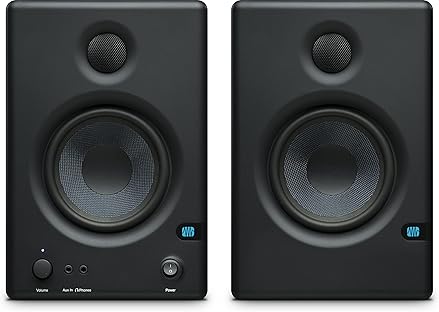Making ground in the music market takes a great deal of effort. Sure, you require raw talent, persistence, interest as well as a great ear for detail, yet you just as need a variety of specialized devices to provide you a clear view of your mixes from all angles.
Of all the equipment located in an average workshop, workshop monitors are certainly one of the most essential pieces. In this short article we are going to highlight ten of the Best Studio Monitors on the market in all price varieties, before taking a more detailed check out monitors and just how to get the most effective out of them. Let’s begin!
Top 10 Workshop Best Studio Monitors
1. Neumann KH 120 A.
The Neumann KH 120 A is a premium active studio monitor known for its exceptional clarity and precise soundstage. Ideal for critical mixing and mastering, it offers a frequency range of 52Hz–21kHz with impressive low-end control for its size. Its Mathematically Modeled Dispersion (MMD) waveguide ensures a consistent listening experience across rooms. With high-grade build quality and acoustic accuracy, this monitor is a top-tier choice for professionals demanding neutral and transparent sound.
Technical Specifications:
- Frequency Response: 52 Hz – 21 kHz
- Amplifier Power: 80W LF, 50W HF
- Max SPL: 111.1 dB
- Inputs: XLR analog input
- Driver Size: 5.25” woofer, 1” tweeter
Pros:
- Exceptional clarity and neutrality for critical listening
- Compact size yet powerful output
- Excellent stereo imaging and transient response
Cons:
- Pricey for beginners
- Lacks onboard room correction features
2. PreSonus Sceptre S8.
The PreSonus Sceptre S8 features CoActual technology combining a coaxial speaker design with DSP tuning, delivering detailed imaging and depth. With an 8-inch woofer and 1.3-inch horn-loaded tweeter, it produces a tight bass response and crisp highs, ideal for large studio environments. Built-in EQ controls allow flexible room tuning. This monitor stands out for its phase coherence and stereo imaging, making it a solid pick for advanced producers and engineers.
Technical Specifications:
- Frequency Response: 38 Hz – 22 kHz
- Amplifier Power: 90W LF, 90W HF
- Max SPL: 116 dB
- Inputs: XLR and 1/4″ TRS combo
- Driver Size: 8” coaxial speaker
Pros:
- Coaxial design ensures phase-coherent sound
- Wide sweet spot and deep bass response
- Advanced DSP tuning options
Cons:
-
Larger footprint, not ideal for small studios
3. Yamaha HS8S.
The Yamaha HS8 Subwoofer enhances your studio’s low-end accuracy with a clean and punchy 150W output. Designed to complement HS series monitors, it offers tight bass extension down to 22Hz. Its low-cut and high-cut controls allow seamless integration into various setups, making it perfect for electronic music production or cinematic sound design. The HS8 Sub is highly reliable, providing clarity without muddiness in the lower frequencies—ideal for balanced mix decisions.
Technical Specifications:
- Frequency Response: 22 Hz – 160 Hz
- Amplifier Power: 150W
- Inputs: XLR and TRS
- Driver Size: 8” bass-reflex powered subwoofer
Pros:
- Perfect companion for Yamaha HS series
- Delivers tight, controlled low-end extension
- Great for bass-heavy production and EDM
Cons:
-
Not a full-range monitor – subwoofer only
4. Adam Sound A5X.
The ADAM Audio A5X delivers detailed high-end and accurate midrange, thanks to its X-ART tweeter and 5.5-inch carbon/Rohacell/glass fiber woofer. Despite its compact size, it delivers a punchy 50W RMS power, great for nearfield applications. Its expansive stereo image and transient response are perfect for critical listening tasks. The rear panel offers flexible connectivity and room adjustment options, making it a favorite among project studios and audio professionals.
Technical Specifications:
- Frequency Response: 50 Hz – 50 kHz
- Amplifier Power: 50W LF, 50W HF
- Max SPL: 110 dB
- Inputs: XLR and RCA
- Driver Size: 5.5” woofer, X-ART ribbon tweeter
Pros:
- Exceptional high-frequency detail with ribbon tweeter
- Front-facing bass ports allow flexible placement
- Low distortion and fast transient response
Cons:
-
Sold individually, doubles the cost for a stereo pair
5. KRK RP8G3-NA.
The KRK Rokit 8 G3 is a popular powered studio monitor offering a full-range, bass-forward sound. With an 8-inch glass-Aramid woofer and 1-inch soft-dome tweeter, it delivers 100W of bi-amped power suitable for EDM, hip-hop, and bass-heavy genres. Its front-firing port minimizes boundary issues, while onboard HF and LF adjustment controls tailor the output to your room. The Rokit 8 is a great value choice for home studios seeking punchy and versatile monitoring.
Technical Specifications:
- Frequency Response: 35 Hz – 35 kHz
- Amplifier Power: 100W
- Max SPL: 109 dB
- Inputs: XLR, TRS, and RCA
- Driver Size: 8” woofer, 1” soft dome tweeter
Pros:
- Versatile input options
- Great bass response, ideal for electronic music
- Affordable and widely used in home studios
Cons:
-
Slight coloration in mids and highs
6. PreSonus Eris E3.5.
The PreSonus Eris E3.5 monitors are a top choice for entry-level producers seeking reliable, studio-quality sound in a compact design. With 3.5-inch Kevlar drivers and silk-dome tweeters, they deliver balanced audio ideal for mixing and casual listening. The front-panel volume control and headphone jack make them perfect for desktop setups. For budget-conscious creators wanting precision and portability, the Eris E3.5 offers impressive clarity and connectivity, including RCA, TRS, and AUX inputs.
Technical Specifications:
- Drivers: 3.5” Kevlar woofer, 1” silk-dome tweeter
- Frequency Response: 80 Hz – 20 kHz
- Power: 50W Class AB
- Inputs: 1/4″ TRS, RCA, 1/8″ stereo
- Dimensions: 6.4″ x 5.6″ x 8.3″ (per speaker)
Pros:
- Affordable for beginners and hobbyists
- Acoustic tuning options help adjust for room acoustics
- Crisp, balanced sound for its size
Cons:
-
Limited low-end response
7. ADAM Sound F5.
The Adam Audio F5 is a professional-grade monitor featuring the brand’s signature X-ART tweeter for incredible high-end detail and accuracy. Its 5-inch woofer handles bass with surprising depth, making it ideal for small studios. Though this model is discontinued (DEMO CLOSEOUT), it remains highly sought-after for its transparent soundstage, dynamic response, and durable build. Perfect for serious producers on a budget looking to score high-end performance at a bargain price.
Technical Specifications:
- Drivers: 5” woofer, proprietary X-ART tweeter
- Frequency Response: 52 Hz – 50 kHz
- Power: 50W RMS
- Inputs: XLR, RCA
- Dimensions: 11″ x 7″ x 9.5″
Pros:
- Exceptional high-frequency detail with extended range
- Compact yet powerful for small studio spaces
- Outstanding stereo imaging
Cons:
-
Sold as a single unit, not a pair
8. IK Multimedia iLoud.
The iLoud Micro Monitor from IK Multimedia redefines portability and sound accuracy. Despite their compact size, these 50-watt monitors deliver powerful, detailed audio with deep lows and crisp highs. Ideal for producers, DJs, and composers on the move, they include Bluetooth connectivity, making wireless mixing and playback effortless. They also support RCA and AUX inputs. These are among the best travel-friendly studio monitors without compromising on reference-grade quality.
Technical Specifications:
- Drivers: 3” woofer, 3/4” tweeter
- Frequency Response: 55 Hz – 20 kHz
- Power: 50W total (25W per speaker)
- Inputs: RCA, 1/8″ AUX, Bluetooth
- Dimensions: 7.1″ x 3.5″ x 5.3″
Pros:
- Compact and highly portable
- Bluetooth capability for wireless playback
- Surprisingly detailed sound and stereo imaging
Cons:
-
Less powerful compared to full-size monitors
9. PreSonus Eris E4.5.
An upgrade from the E3.5, the PreSonus Eris E4.5 monitors offer fuller sound with 4.5-inch drivers that handle low-end frequencies better. Ideal for home studios and multimedia setups, they feature the same acoustic tuning controls, balanced/unbalanced inputs, and front-panel convenience. The increased power and headroom make them better suited for semi-professional mixing, podcasting, and content creation. For creators seeking reliable audio precision in a desktop format, the E4.5 is a solid step up.
Technical Specifications:
- Drivers: 4.5” Kevlar woofer, 1” silk-dome tweeter
- Frequency Response: 70 Hz – 20 kHz
- Power: 50W Class AB
- Inputs: TRS, RCA, 1/8″ stereo
- Dimensions: 6.4″ x 9.45″ x 7″
Pros:
- Greater bass extension than E3.5
- Solid build and accurate sound
- Front-panel volume and headphone jack
Cons:
-
Still not deep enough for serious bass-heavy production
10. Tascam VL-S3.
Tascam’s VL-S3BT monitors combine studio-grade accuracy with modern wireless convenience. With 14 watts of total power and Bluetooth support, they are perfect for casual music producers or content creators wanting to simplify their setup. The 3-inch woofers and 0.5-inch tweeters deliver a surprisingly clear sound in small spaces. Though not ideal for deep bass-heavy production, their compact size and ease of use make them a great fit for podcasting or mobile studios.
Technical Specifications:
- Drivers: 3” woofer, 0.5” tweeter
- Frequency Response: 80 Hz – 22 kHz
- Power: 14W RMS
- Inputs: RCA, Bluetooth
- Dimensions: 5.6″ x 4.3″ x 6.8″
Pros:
- Built-in Bluetooth for flexible connectivity
- Compact and suitable for casual creators
- Budget-friendly option
Cons:
-
Limited volume and headroom
What are Screen Speakers?
Before we have a look at just how to buy and also exactly how to obtain the best out of your displays, it’s possibly worth defining just what monitoring speakers are. It can be a little confusing, particularly to finish beginners, as a workshop display can look like your typical bookshelf speaker– nonetheless, their function is entirely different.
So, what are they?
Allow’s start by considering making music. Creating good music is only half the fight. Making good songs audio good on every system out there is the real test of a fantastic manufacturer!
Why is this an issue? Ultimately everything boils down to audio speaker prejudice and how they were set up from the manufacturing facility. For instance, some audio speakers and also earphones are truly bass heavy. In budget friendly systems, makers often like to chill out the low-end because it gives the sound a bit much more girth, while perhaps concealing shortages in other parts of the frequency range.
At the other end of the spectrum we have more costly systems, where each speaker may have numerous chauffeurs, each charged with dealing with a specific band of the regularity range. Developing an opus that will sound excellent on both budget as well as premium speakers is not as easy as it appears.
This is where workshop monitors can be found in. Take a look at them as a screening gear.
Openness and also Surveillance.
Nowadays, ‘openness’ has become a bit of an abstract term. It gets considered without much description. A simple means to describe openness is to make use of a simple chart. Your upright axis is gauged in decibels (in other words, volume), while the straight axis stands for the regularity array.
To your left will certainly be the lowest frequency that the audio speaker can reproduce, while the right side is the highest possible. These kinds of graphs are made by putting a microphone alongside the speaker and taping the result.
If we take a typical set of shelf speakers as well as do this test, chances are you’ll see a favorable contour in the reduced frequencies, which after that dips as it reaches the mids, prior to increasing again in the trebles. This tells you which frequencies are louder, as well as which ones are not pushed as hard.
Power as well as Power Monitoring.
Lots of people connect power determined in watts with volume. However, power influences numerous various other points, which are much more important.
There are 2 kinds to note– energetic and easy devices. Energetic speakers are those that have a built-in amplifier, indicating that they require no outside amplification. Easy audio speakers are the complete reverse. In order to run these, you will have to acquire a standalone amp.
In 2018, energetic displays are essentially the norm. These speakers will certainly vary in terms of the number of power amps are consisted of per cabinet. Usually talking, more affordable versions will only have a solitary amp to press both transducers. Obviously, you can additionally find premium tri-amp audio speakers, with private amps powering high, mid and low frequencies.
How to Correctly Position Workshop Screen.
Unlike typical shelf speakers, usually workshop screens are ‘nearfield’. This implies that they create the most effective outcomes when the individual is just a meter or two away from the audio speaker (i.e. ‘near’). The further away you are, the much less interpretation you’ll have. So, when you are resting this near to the speaker, you will certainly require to have them establish properly for optimal noise.
The good news is, positioning the speakers is not that complicated if you adhere to a set of easy rules:.
First of all, make sure the audio speakers are level with your head and aimed at you. Picture that a laser beam is firing from the facility of those vehicle drivers. You desire the beam of light from each cupboard to be aimed at your head.
Next, guarantee that the two speakers as well as your head form an equidistant triangle. This will enable the acoustic waves from each speaker to reach you without dispute.
Taking Care Of Area Acoustics and Standing Waves.
Following on from the vital topic of positioning is the equally essential topic of room acoustics and standing waves. Every room, no matter what dimension or form, will certainly affect the performance of your audio speakers. This is mainly due to the nature of sound waves and also exactly how they move via area.
Every wave has a length, with greater regularity wavelengths being much shorter and lower frequency wavelengths being longer.
Simply put, a standing wave stresses one specific frequency, indicating you will hear this wave prominently as the representations enhance each other. Normally, this frustrating event influences the quality of the sound and your capacity to do your task.
So just how do you take care of standing waves? The best means to tackle this is to place your speakers along the lengthiest wall you have and also leave at least 3 or more feet in between the back of the speakers and the wall surface. If your audio speaker includes area acoustic setups, you can tune the audio speaker to the shapes and size of your space and cut the angering frequency. This can aid remove the issue of standing waves.
Selecting the Right Set of Monitor Audio Speakers.
Since we know what displays are, what they do and how they function, let’s talk a bit about picking the best displays for you. Certainly, finding the ideal set for you will rely upon a several variables. In this area we will certainly help you establish just what you ought to be seeking!
Budget.
Determining just how much cash to invest in a set of checking audio speakers is one of those choices that might difficulty you for a while (although do not shed any sleep over it!). You can invest anything from under $100 to more than $3,000 on a set of speakers, however your present ability, your desires as well as your budget will certainly identify what you must invest.
If you are simply starting out, buying something in the inexpensive area– from under $200 right approximately around $500– will certainly be a great phone call. Even having something under $100 is better than not having tracking audio speakers. Inevitably, also the cheapest pair of monitors will certainly make out better than a wonderful set of bookshelf audio speakers for a producer who cares about just how their songs truly seems.
Learn on something decent that won’t destroy your savings account and you can constantly upgrade later.
Dimension.
Drawing some verdicts from our earlier discussion, discovering the right size of speakers is critical if you want to get the very best value. However, determining the right dimension for you counts on a lot of guesswork!
Inevitably it is important to take into consideration the room you will be full of these speakers. If it’s a little studio (around the size of a conventional bed room for instance), do not come under the usual catch of going for the largest set you can afford. In these scenarios, having smaller vehicle drivers– no more than around 5″– will give you the sharpest, most defined noise. A bigger studio, such as a cellar, will certainly require bigger motorists of around 8″.
Brand names.
As with any kind of audio tools– from electric guitars to microphones– there is a component of brand name snobbery and brand loyalty amongst many manufacturers. Naturally, when it pertains to keeping track of audio speakers, we would certainly all enjoy to have a collection of premium ATCs or Focals, yet that doesn’t imply disappointing these won’t land you with a seriously great noise. Fortunately for the deal seekers and those on a spending plan, an increasing number of manufacturers are expanding their schedules to include even more economical designs.
The vital takeaway below is to not dive straight for the initial brand you recognize, particularly if you are a novice. If you are brand-new to audio devices, you may not have come across brand names such as Mackie or PreSonus, but they supply some exceptional budget choices alongside their high-end lines.
Can Headphones Be Utilized As Opposed To Monitors?
This is a great question as well as one that appears often. The brief response is no– keeping an eye on headphones can not change a great set of screens. Even with open-back headphones that have wonderful meaning and an outstanding audio stage, you still won’t accomplish same outcomes as screens. Even if your studio lacks correct seclusion, or you mix in your home and just can not have the songs blowing up out the audio speakers, we still suggest opting for monitors at a really reduced quantity.
Nonetheless, earphones are still an awesome device that certainly do have their area in mixing! You might be amazed at what listening differently can expose.
Eventually ‘Audio Speakers vs. Earphones’ is the upside-down of taking a look at points. It’s not an either/or circumstance, rather a ‘both’ scenario– where making use of one to match the various other supplies the most effective outcomes. We have an extensive overview on studio earphones, so be sure to have a look after you have actually decided on your speakers!
The Final Word.
We wish we have actually reinforced the importance of studio screens for expert as well as enthusiast producers, engineers and also vital listeners of all kinds. We additionally hope we have actually addressed several of your inquiries about keeping an eye on audio speakers.
Whether you are on a limited budget, or you are seeking something a bit higher on the ladder, the designs we have discussed ought to have offered you some ideas, yet take your time with your decision. You will with any luck end up with the Best Studio Monitors for your setup, which will confirm a powerful workshop partner for several years to come!
Related articles:
